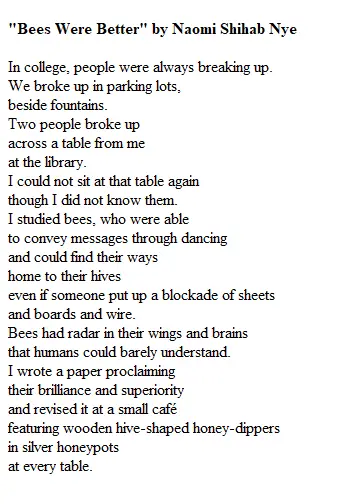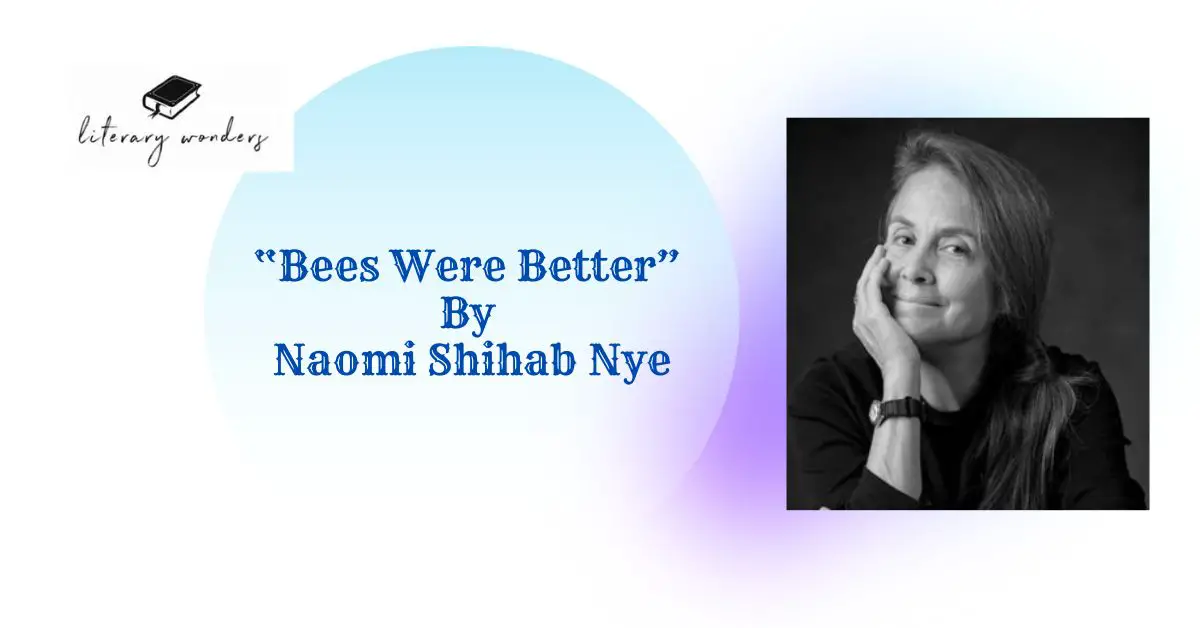Introduction to “Bees Were Better”

Written by Naomi Shihab Nye, a phenomenal writer and poet, “Bees Were Better” is a reflective poem. It examines the frailty of interpersonal connections seen in college. Everywhere, there were splits, from parking lots to libraries. The poet considers a specific breakup that permanently marred a library table. In the middle of this, the poet turns to bees, marveling at their capacity to navigate home while overcoming obstacles and communicating through dancing.
Her fascination with bees sprang from their cryptic intellect and radar-equipped wings. She wrote a paper praising their genius, which she later edited in a coffee shop decorated with honey-related decor. In this poem, the complex world of bees is compared to the nuanced human emotions and interpersonal connections.
Summary of “Bees Were Better”
The poem depicts the spirit of college life, where the intricacies of romantic relationships, particularly breakups, are a recurrent motif. The poem depicts these breakups vividly, showing them taking place in various locations, including parking lots, fountains, and even the peaceful corners of a library.
As Nye describes seeing a split at a library table, an experience that imprinted on her, her narration exudes a feeling of detachment. The poet then turns her attention to bees, which results in an unexpected turn in the poem. She is in awe of the bees’ extraordinary skills, including how they return to their colonies without error despite barriers and perform complicated dances to communicate.
The poet makes an evocative comparison between the complex realm of human emotions and bees’ superficially basic yet extraordinarily sophisticated intelligence. She fervently composes a paper praising the genius of these insects, which she later reads again in a charming café with honey-themed decor.
The poem highlights the resiliency and wisdom of the natural world through this investigation, comparing it with the difficulties of interpersonal interactions encountered throughout the college years.
Major Themes in “Bees Were Better”
The writer intertwined many ideas to produce an engaging reflection on the complexity of human emotions and the inherent wisdom present in the natural world. Beginning by reflecting on the recurrent theme of breakups in college life, the poem highlights the emotional turmoil and brittleness of interpersonal connections.
It examines the long-term consequences of these breakups. Another example of the poet’s feeling of distance is his observation of a breakup from across a library table. The idea of being a spectator to other people’s emotional lives is emphasized by this observational topic. The speaker also draws comparisons between human complexity and the clarity and intelligence found in nature, particularly in the behavior of bees.
The sophistication of the natural world is highlighted by the bees’ emphasis on their capacity for communication and manoeuvring. Through an examination of bees, the poem examines the concept of resiliency. The resilience and power of bees in the face of difficulties are demonstrated by their capacity to overcome obstacles and find their nests. The poet’s fascination with bees and her determination to write a paper about them call attention to the problem of intellectual curiosity and zeal for learning.
It emphasizes the importance of pursuing your passions and finding inspiration in unexpected places. The poem highlights the idea that nature frequently includes lessons and wisdom that humans find challenging to fully understand by implying that bees are cleverer than humans.
Literary Elements Used in “Bees Were Better”
Imagery: The poem uses sensory elements to describe the breakup situations in college, the library, and the café. The setting and events are vividly described, bringing them to life for the reader.
- Alliteration: The poem gains musicality from the recurrence of consonant sounds, especially in words like “beside fountains” and “blockade of sheets and boards,” which give the poem a rhythmic feel.
- Contrast: The poem clearly distinguishes between bees’ calm, deliberate conduct and the volatility of human emotions and relationships. This jarring contrast emphasizes the topics of the poem.
- Irony: The poem’s title, “Bees Were Better,” hints at irony by implying that bees are, in some ways, superior to humans. This is both hilarious and thought-provoking.
- Metaphor: The apparent simplicity and intelligence of bees are used to contrast the complexity of human interactions with those of these insects. They stand for flexibility, communication, and resilience.
- Personification: The poem gives bees human characteristics by describing them as having the capacity to dance and communicate. The poet’s fondness for these species is highlighted by this personification.
- Repetition: The poet expresses his fondness for bees and underscores the notion that they possess higher intelligence by using the word “brilliance” repeatedly.
- Symbolism: In the café, wooden hive-shaped honey-dippers and silver honeypots represent the poet’s close relationship with bees and her commitment to learning about them. They stand for her academic curiosity and devotion.
The analysis shows that these devices as made this poem thought-provoking for the readers.
FAQS about “Bees Were Better”
1. What is the central theme of the poem?
The poem’s main idea contrasts the difficulties of interpersonal relationships, especially breakups during college, with the sagacity and fortitude demonstrated by bee behavior.
2. The poet mentions seeing a split at the library table, but why?
The poet refers to this incident to emphasize how it affected her and to set the stage for her analysis of bees. It was a turning point that inspired her to study bees for comfort and motivation.
3. What purpose do the bees serve in the poem?
In metaphor, traits like communication, adaptability, and resilience are represented by bees. They reflect the poet’s awe of nature and inquiry into the opposition between human emotions and nature’s knowledge.
4. How does the poet convey her meaning through language and imagery?
The poet describes breakups and the bee world with wonderful imagery. She uses alliteration, personification, and metaphors to improve the reader’s comprehension and connection with the subjects.
5. What irony is intended by the poem’s “Bees Were Better” title?
The irony is in the thought-provoking and funny claim that bees are, in some ways, superior to humans. It makes readers ponder nature’s inherent wisdom.
6. What function does the honey-themed café perform in the poem?
The honey-themed café reflects the poet’s enthusiasm for her subject. She revisits her paper on bees in this environment, demonstrating her intellectual interest and commitment to her studies.
7. How is the idea of observation and detachment explored in the poem?
The poem considers the poet’s position as a bystander to human breakups, highlighting the poet’s feeling of objectivity as she observes these events. Her strong bond with the bee community contrasts with this remoteness.
Suggested Readings

